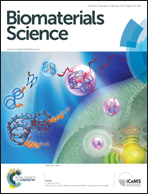The effects of poly(dimethylsiloxane) surface silanization on the mesenchymal stem cell fate
Abstract
In recent years, poly(dimethylsiloxane) (PDMS)-based microfluidic devices have become very popular for on-chip cell investigation. Maintenance of mammalian cell adhesion on the substrate surface is crucial in determining the cell viability, proliferation and differentiation. However, the inherent hydrophobicity of PDMS is unfavourable for cell culture, causing cells to eventually dislodge from the surface. Although physically adsorbed matrix proteins can promote initial cell adhesion, this effect is usually short-lived. To address this critical issue, in this study, we employed (3-aminopropyl) triethoxy silane (APTES) and cross-linker glutaraldehyde (GA) chemistry to immobilize collagen type 1 (Col1) on PDMS. These modified surfaces are highly efficient to support the adhesion of mesenchymal stem cells (MSCs) with no deterioration of their potency. Significant changes of the native PDMS surface properties were observed with the proposed surface functionalization, and MSC adhesion was improved on PDMS surfaces modified with APTES + GA + Protein. Therefore, this covalent surface modification could generate a more biocompatible platform for stabilized cell adhesion. Furthermore, this modification method facilitated long-term cell attachment, which is favourable for successful induction of osteogenesis and cell sheet formation with an increased expression of osteogenic biomarkers and comparable extracellular matrix (ECM) constituent biomarkers, respectively. The surface silanization can be applied to PDMS-based microfluidic systems for long-term study of cellular development. Similar strategies could also be applied to several other substrate materials by appropriate combinations of self-assembled monolayers (SAMs) and ECM proteins.

- This article is part of the themed collection: Biomaterials Science 10th Anniversary: Top papers from Asia-Pacific

 Please wait while we load your content...
Please wait while we load your content...